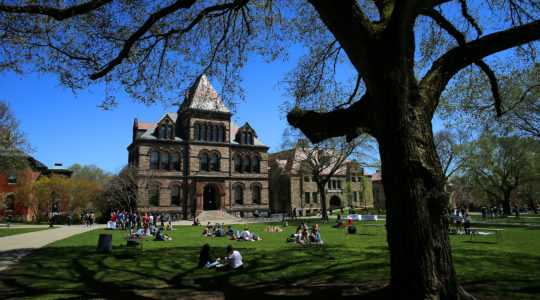Jewish camps hold steady, look to improve online presence: Some 500 representatives of 112 camps met March 14-15 in Jersey City, N.J., for the biannual conference of the Foundation for Jewish Camp.
The Jewish camping industry experienced a huge boon over the past decade. Yet a year ago many camps had serious concerns that the growth could recede with the stumbling economy.
In speaking with a number of camp officials at the Westin Hotel along the waterfront, however, the sentiment seemed to be that the worst has past and camps by and large were able to hold steady.
Historically, according to FJC chairman Skip Vichness, camps have suffered greatly in economic crises. Yet that did not happen this go-round, he said, even though the latest recession appeared to be much deeper than some in the past.
While past recessions have seen about a 10 percent drop in enrollment in Jewish overnight camps, this time the numbers were steady: Campership grew from 43,000 11 years ago to about 70,000 in 2008, Vichness said, and the ’08 number held last summer.
Looking forward to the summer of 2010, the number should hold steady and perhaps grow, the camp foundation’s new CEO, Jeremy Fingerman, told me.
“Anecdotally, in talking with the camp directors, the overall the impression I had is they were pretty even with a year ago,” Fingerman said. “A number of camps already have waiting lists. Other camps are close to being filled, though I think it ranges across the country. Camps in the Southeast, Southwest and West Coast are closer to being full. And I have a list of camps looking to do cabins expansion.”
The expansion could be helped with a new matching-grant program started by the FJC to help camps add cabins and increase capacity. Fingerman said he knows of at least a dozen camps that are ready to build new cabins.
The steadiness of camp enrollment could be attributed in part to the millions of dollars that the FJC and the Jim Joseph Foundation have invested in supplying scholarship incentives to first-time campers in 30 communities.
But in talking with those at the camps, it seems the bigger factor is that they were able to really focus over the past year. Most camps basically raise philanthropic money for two things — capital projects and scholarships. Tuition pays for the actual running of the camps.
Over the past 18 months, most camps have put on hold raising funds for capital improvements by and large and laser focused on raising money for scholarships, as the camps have seen a significant spike in parents who need financial aid.
Donors have been receptive, it seems.
For instance, Camp Ramah of the Berkshires at a recent dinner raised $325,000 for scholarships — its most ever, according to development director Amy Glazer. It did so by focusing more on midrange donors of $300-$1,200 rather than large donors.
Herrell Wittenstein, the director of camp services for B’nai B’rith International, said his organization was able to bring in $100,000 for scholarships for the several camps it runs — about $40,000 more than in the past.
Fingerman, a branding wizard at Campbell’s Soup and Manischewitz before moving to the FJC this winter, has his own theory: He says much of the stability in camps has to do with the strength of the Jewish camp brand and the trust that parents have in it.
“Trust today is expressed parent to parent, family to family, camper to friend,” he said. “It is that word of mouth that is critical. So a positive experience is worth a tremendous amount. If you don’t have a good experience, [you won’t pass it on].”
Still, much of the conference focused on how Jewish camps can move beyond simple word of mouth in terms of passing on and marketing that brand.
The conference’s keynote speaker was a brand wizard, and several sessions focused on social media and branding itself.
Fingerman says camps have significant strides to make, especially in the realm of online marketing.
“If you look at the online presence of the camps that we support and try to help and assist, while there is a range of capability we are not marketing to today’s consumers and parents and kids in a way that is as effective as should be,” he said. “If you look at some of the private [non-Jewish] camp Web sites, your jaw drops. I look at these Web sites and I say sign me up, I want to go to camp. They are great camps, but they are missing the Jewish neshama we try to support.
"You look at those Web sites [of the Jewish camps], and look at how they are, they are static, not fresh. They are not active in communicating the strength of the brand.”
JTA has documented Jewish history in real-time for over a century. Keep our journalism strong by joining us in supporting independent, award-winning reporting.





